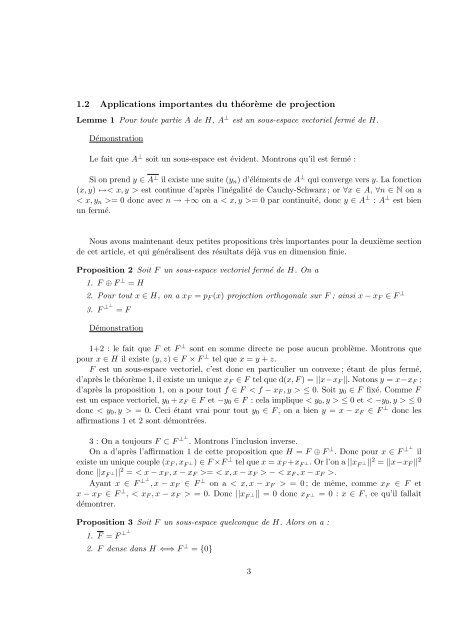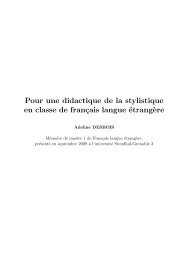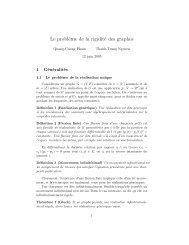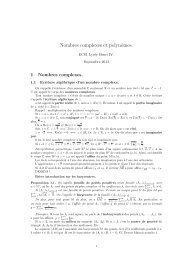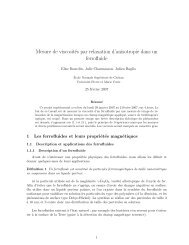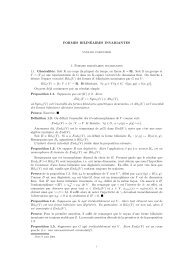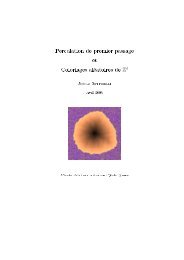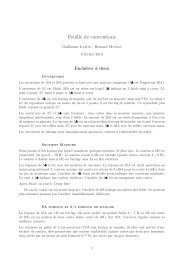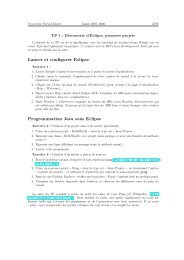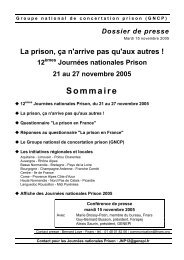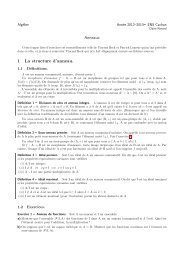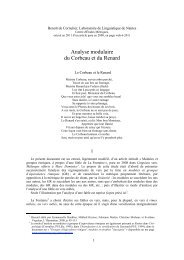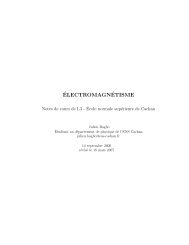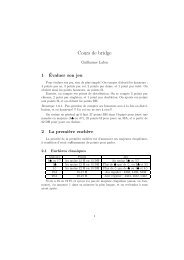Le théorème de représentation de Riesz dans un ... - Normalesup.org
Le théorème de représentation de Riesz dans un ... - Normalesup.org
Le théorème de représentation de Riesz dans un ... - Normalesup.org
You also want an ePaper? Increase the reach of your titles
YUMPU automatically turns print PDFs into web optimized ePapers that Google loves.
1.2 Applications importantes du <strong>théorème</strong> <strong>de</strong> projection<br />
<strong>Le</strong>mme 1 Pour toute partie A <strong>de</strong> H, A ⊥ est <strong>un</strong> sous-espace vectoriel fermé <strong>de</strong> H.<br />
Démonstration<br />
<strong>Le</strong> fait que A ⊥ soit <strong>un</strong> sous-espace est évi<strong>de</strong>nt. Montrons qu’il est fermé :<br />
Si on prend y ∈ A ⊥ il existe <strong>un</strong>e suite (yn) d’éléments <strong>de</strong> A ⊥ qui converge vers y. La fonction<br />
(x, y) ↦→< x, y > est continue d’après l’inégalité <strong>de</strong> Cauchy-Schwarz ; or ∀x ∈ A, ∀n ∈ N on a<br />
< x, yn >= 0 donc avec n → +∞ on a < x, y >= 0 par continuité, donc y ∈ A ⊥ : A ⊥ est bien<br />
<strong>un</strong> fermé.<br />
Nous avons maintenant <strong>de</strong>ux petites propositions très importantes pour la <strong>de</strong>uxième section<br />
<strong>de</strong> cet article, et qui généralisent <strong>de</strong>s résultats déjà vus en dimension finie.<br />
Proposition 2 Soit F <strong>un</strong> sous-espace vectoriel fermé <strong>de</strong> H. On a<br />
1. F ⊕ F ⊥ = H<br />
2. Pour tout x ∈ H, on a xF = pF (x) projection orthogonale sur F ; ainsi x − xF ∈ F ⊥<br />
3. F ⊥⊥<br />
= F<br />
Démonstration<br />
1+2 : le fait que F et F ⊥ sont en somme directe ne pose auc<strong>un</strong> problème. Montrons que<br />
pour x ∈ H il existe (y, z) ∈ F × F ⊥ tel que x = y + z.<br />
F est <strong>un</strong> sous-espace vectoriel, c’est donc en particulier <strong>un</strong> convexe ; étant <strong>de</strong> plus fermé,<br />
d’après le <strong>théorème</strong> 1, il existe <strong>un</strong> <strong>un</strong>ique xF ∈ F tel que d(x, F ) = ||x−xF ||. Notons y = x−xF ;<br />
d’après la proposition 1, on a pour tout f ∈ F < f − xF , y > ≤ 0. Soit y0 ∈ F fixé. Comme F<br />
est <strong>un</strong> espace vectoriel, y0 + xF ∈ F et −y0 ∈ F : cela implique < y0, y > ≤ 0 et < −y0, y > ≤ 0<br />
donc < y0, y > = 0. Ceci étant vrai pour tout y0 ∈ F , on a bien y = x − xF ∈ F ⊥ donc les<br />
affirmations 1 et 2 sont démontrées.<br />
3 : On a toujours F ⊂ F ⊥⊥.<br />
Montrons l’inclusion inverse.<br />
On a d’après l’affirmation 1 <strong>de</strong> cette proposition que H = F ⊕ F ⊥ . Donc pour x ∈ F ⊥⊥ il<br />
existe <strong>un</strong> <strong>un</strong>ique couple (xF , xF ⊥) ∈ F ×F ⊥ tel que x = xF +xF ⊥. Or l’on a ||xF ⊥|| 2 = ||x−xF || 2<br />
donc ||xF ⊥|| 2 = < x − xF , x − xF >= < x, x − xF > − < xF , x − xF >.<br />
Ayant x ∈ F ⊥⊥,<br />
x − xF ∈ F ⊥ on a < x, x − xF > = 0 ; <strong>de</strong> même, comme xF ∈ F et<br />
x − xF ∈ F ⊥ , < xF , x − xF > = 0. Donc ||xF ⊥|| = 0 donc xF ⊥ = 0 : x ∈ F , ce qu’il fallait<br />
démontrer.<br />
Proposition 3 Soit F <strong>un</strong> sous-espace quelconque <strong>de</strong> H. Alors on a :<br />
1. F = F ⊥⊥<br />
2. F <strong>de</strong>nse <strong>dans</strong> H ⇐⇒ F ⊥ = {0}<br />
3


